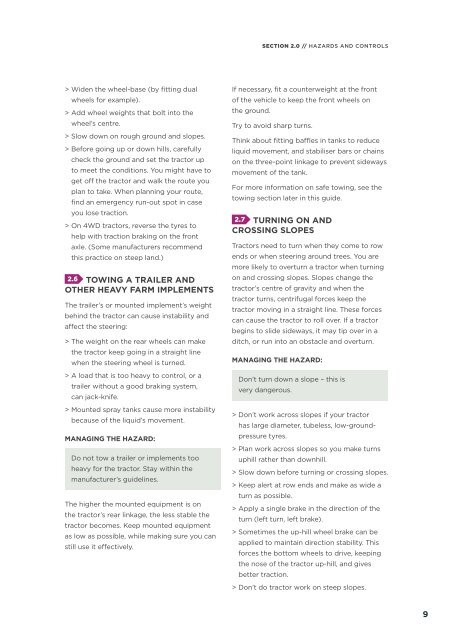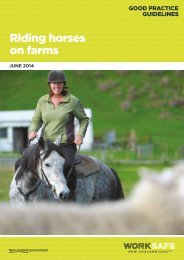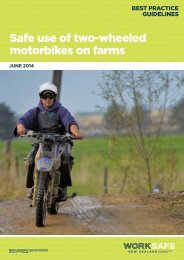tractors-on-farms-pdf
tractors-on-farms-pdf
tractors-on-farms-pdf
Create successful ePaper yourself
Turn your PDF publications into a flip-book with our unique Google optimized e-Paper software.
SECTION 2.0 // HAZARDS AND CONTROLS> > Widen the wheel-base (by fitting dualwheels for example).> > Add wheel weights that bolt into thewheel’s centre.> > Slow down <strong>on</strong> rough ground and slopes.> > Before going up or down hills, carefullycheck the ground and set the tractor upto meet the c<strong>on</strong>diti<strong>on</strong>s. You might have toget off the tractor and walk the route youplan to take. When planning your route,find an emergency run-out spot in caseyou lose tracti<strong>on</strong>.> > On 4WD <str<strong>on</strong>g>tractors</str<strong>on</strong>g>, reverse the tyres tohelp with tracti<strong>on</strong> braking <strong>on</strong> the fr<strong>on</strong>taxle. (Some manufacturers recommendthis practice <strong>on</strong> steep land.)2.6 TOWING A TRAILER ANDOTHER HEAVY FARM IMPLEMENTSThe trailer’s or mounted implement’s weightbehind the tractor can cause instability andaffect the steering:> > The weight <strong>on</strong> the rear wheels can makethe tractor keep going in a straight linewhen the steering wheel is turned.> > A load that is too heavy to c<strong>on</strong>trol, or atrailer without a good braking system,can jack-knife.> > Mounted spray tanks cause more instabilitybecause of the liquid’s movement.MANAGING THE HAZARD:Do not tow a trailer or implements tooheavy for the tractor. Stay within themanufacturer’s guidelines.The higher the mounted equipment is <strong>on</strong>the tractor’s rear linkage, the less stable thetractor becomes. Keep mounted equipmentas low as possible, while making sure you canstill use it effectively.If necessary, fit a counterweight at the fr<strong>on</strong>tof the vehicle to keep the fr<strong>on</strong>t wheels <strong>on</strong>the ground.Try to avoid sharp turns.Think about fitting baffles in tanks to reduceliquid movement, and stabiliser bars or chains<strong>on</strong> the three-point linkage to prevent sidewaysmovement of the tank.For more informati<strong>on</strong> <strong>on</strong> safe towing, see thetowing secti<strong>on</strong> later in this guide.2.7 TURNING ON ANDCROSSING SLOPESTractors need to turn when they come to rowends or when steering around trees. You aremore likely to overturn a tractor when turning<strong>on</strong> and crossing slopes. Slopes change thetractor’s centre of gravity and when thetractor turns, centrifugal forces keep thetractor moving in a straight line. These forcescan cause the tractor to roll over. If a tractorbegins to slide sideways, it may tip over in aditch, or run into an obstacle and overturn.MANAGING THE HAZARD:D<strong>on</strong>’t turn down a slope – this isvery dangerous.> > D<strong>on</strong>’t work across slopes if your tractorhas large diameter, tubeless, low-groundpressuretyres.> > Plan work across slopes so you make turnsuphill rather than downhill.> > Slow down before turning or crossing slopes.> > Keep alert at row ends and make as wide aturn as possible.> > Apply a single brake in the directi<strong>on</strong> of theturn (left turn, left brake).> > Sometimes the up-hill wheel brake can beapplied to maintain directi<strong>on</strong> stability. Thisforces the bottom wheels to drive, keepingthe nose of the tractor up-hill, and givesbetter tracti<strong>on</strong>.> > D<strong>on</strong>’t do tractor work <strong>on</strong> steep slopes.9







